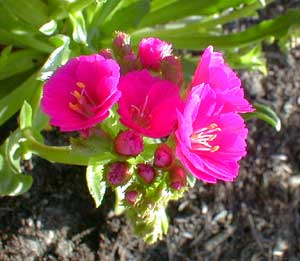 | |
"Jack, oh, Jack, what's in your sack,
Questionable Daycare Poems & Stories, j.a.s. | |
Hot Pink Cliff Maids
I'd been struggling against the Lewisia addiction. When I'd reached the first dozen or so specimens, I told myself I would not add any more of them to the rocky ledge, unless, of course, I saw one that was strikingly different. So wouldn't you know it, I find one with the cerise or hot pink blooms, a color I had never before seen on any Cliff's Maid.
The blooms were smaller than on the average floriferous hybrid though slightly larger than some wilder strains. Though some lewisias have bigger blooms, this one makes a stronger than average impact with its unbelievably bright color, & its larger than average yellow-tipped anthers.
It is beginning to flower by early April, & in full flower by mid-April. Since it was unnamed from a "mixed" group, I'll never really know this specimen's hybrid heritage, but the thinner than average leaves & the unusual pinkness of the flower lends me to believe it has L. columbiana in its make-up.
In Puget Sound gardens the main enemy of a Lewisia is too much rainfall. Many recommend gritty soil that does not hold moisture. I happen to use a rich loamy soil, but plant them along a raised stone ledge for the sharpest drainage. When I obtained the Hot Pink lewisia, it had been overwatered in the nursery, & some of its lower leaves had yellowed & softened. Worried that it might get root-rot, I placed it in the sunniest position, & added a layer of black acquarium gravel all about its base so that the leaves would never be sitting directly on wet soil. Whether that was necessary is hard to say, but it did soon recover.
Lewisias in the main prefer full-sun, but some of ours are doing fine in partial shade as a couple of deciduous trees overhang part of their garden. The only result of this is that most of the ones out in fullest sun begin blooming two to four weeks earlier than the ones in part shade, although even this varies.
They may in fact struggle in too much sun, especially if their roots are too heated. "Sun with some protection" works best. The "protection" can be nothing more than nearby perennials that shades the Lewisias at height of summer, or a few rocks strategically placed to protect just the roots, so that only the leaves are in the sun, as in nature the roots frequently are wedged between cooling stones or stone cracks.
Lewisia cotyledon f. alba